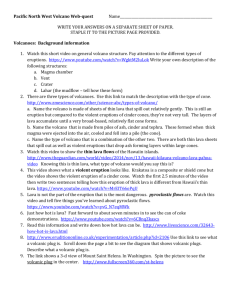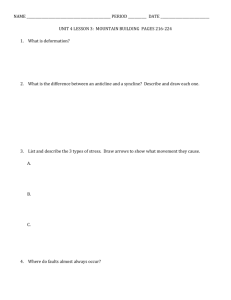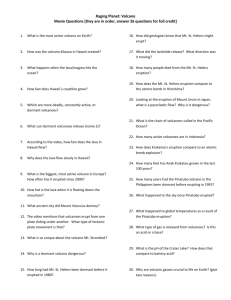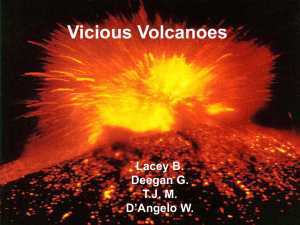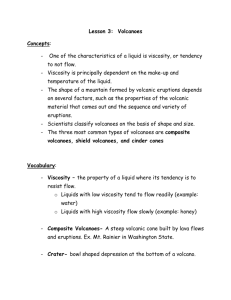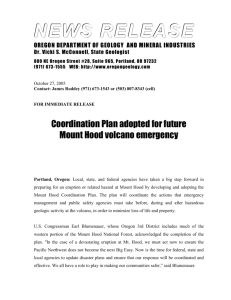Webquest Pacific Northwest Volcanoes
advertisement
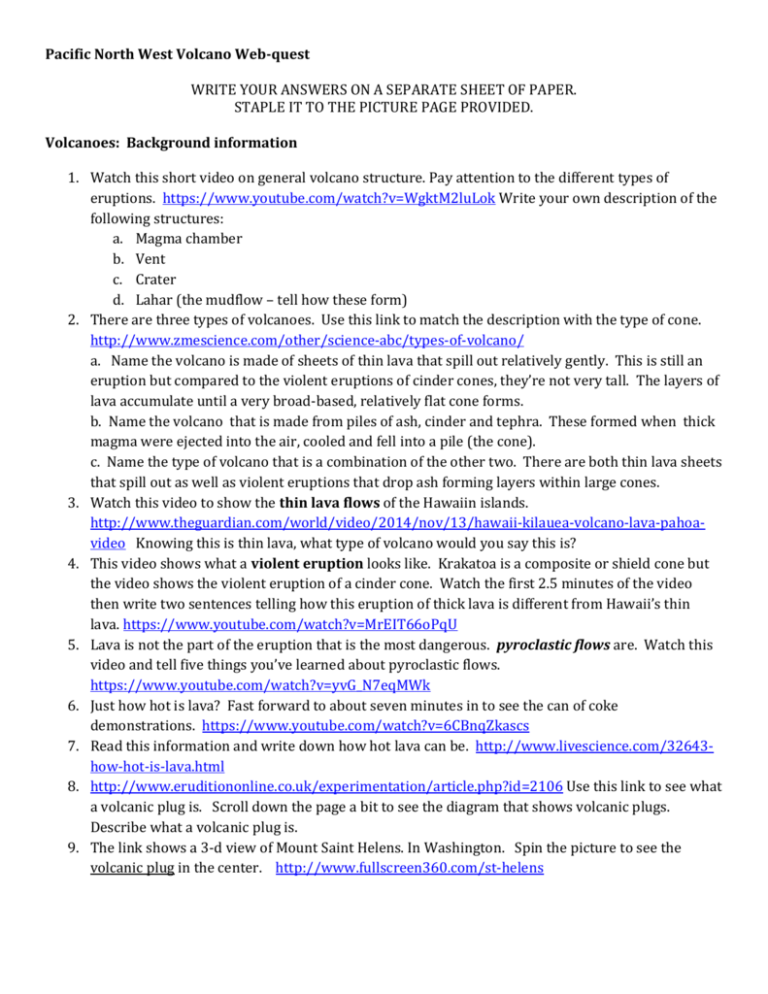
Pacific North West Volcano Web-quest WRITE YOUR ANSWERS ON A SEPARATE SHEET OF PAPER. STAPLE IT TO THE PICTURE PAGE PROVIDED. Volcanoes: Background information 1. Watch this short video on general volcano structure. Pay attention to the different types of eruptions. https://www.youtube.com/watch?v=WgktM2luLok Write your own description of the following structures: a. Magma chamber b. Vent c. Crater d. Lahar (the mudflow – tell how these form) 2. There are three types of volcanoes. Use this link to match the description with the type of cone. http://www.zmescience.com/other/science-abc/types-of-volcano/ a. Name the volcano is made of sheets of thin lava that spill out relatively gently. This is still an eruption but compared to the violent eruptions of cinder cones, they’re not very tall. The layers of lava accumulate until a very broad-based, relatively flat cone forms. b. Name the volcano that is made from piles of ash, cinder and tephra. These formed when thick magma were ejected into the air, cooled and fell into a pile (the cone). c. Name the type of volcano that is a combination of the other two. There are both thin lava sheets that spill out as well as violent eruptions that drop ash forming layers within large cones. 3. Watch this video to show the thin lava flows of the Hawaiin islands. http://www.theguardian.com/world/video/2014/nov/13/hawaii-kilauea-volcano-lava-pahoavideo Knowing this is thin lava, what type of volcano would you say this is? 4. This video shows what a violent eruption looks like. Krakatoa is a composite or shield cone but the video shows the violent eruption of a cinder cone. Watch the first 2.5 minutes of the video then write two sentences telling how this eruption of thick lava is different from Hawaii’s thin lava. https://www.youtube.com/watch?v=MrEIT66oPqU 5. Lava is not the part of the eruption that is the most dangerous. pyroclastic flows are. Watch this video and tell five things you’ve learned about pyroclastic flows. https://www.youtube.com/watch?v=yvG_N7eqMWk 6. Just how hot is lava? Fast forward to about seven minutes in to see the can of coke demonstrations. https://www.youtube.com/watch?v=6CBnqZkascs 7. Read this information and write down how hot lava can be. http://www.livescience.com/32643how-hot-is-lava.html 8. http://www.eruditiononline.co.uk/experimentation/article.php?id=2106 Use this link to see what a volcanic plug is. Scroll down the page a bit to see the diagram that shows volcanic plugs. Describe what a volcanic plug is. 9. The link shows a 3-d view of Mount Saint Helens. In Washington. Spin the picture to see the volcanic plug in the center. http://www.fullscreen360.com/st-helens Pacific North West Volcanoes 10. Add these volcanoes to map on your picture page: Mt. St. Helens, Mt. Hood, Crater lake, Newberry Crater, Mt. Ranier . Use this link to find their location: http://www.biblesearchers.com/catastrophes/timeofend/pacificnorthwest_files/image002.jpg 11. This link shows local volcanoes seismicity in the last thirty days. Go back to the map and put a star next to the volcanoes that have been active in the last thirty days. https://pnsn.org/volcanoes Mount Hood 12. Use this link to answer the next set of questions about Mount Hood. http://pubs.usgs.gov/fs/2000/fs060-00/ a. When did Mount Hood last erupt? b. What is a lava dome? Circle the lava dome on the picture page provided. c. What does the USGS say about Mount Hood and pyroclastic flows? d. What does the site tell you about Mount Hood’s lahars? e. Who named the Sandy River and why did they name it that? f. On your picture page, explain the picture on the right. 13. This brief article was in the Oregonian in March 2015. From it, list signs that Mount Hood is indeed an active volcano that could erupt. http://www.oregonlive.com/pacific-northwestnews/index.ssf/2015/03/volcano_monitoring_stations_pr.html 14. This article explains how Mount Hood could go active. Write two or three sentences that summarize the article. (What are the most important things you think the reader should take away from the article.) http://oregonstate.edu/ua/ncs/archives/2014/feb/study-volcanoes-including-mt-hood-can-godormant-active-quickly Volcanic Plugs (Haystack Rock at Cannon Beach, Beacon Rock in the Columbia) 15. In question #8 you learned about volcanic plugs. Next to your pictures of Haystack Rock and Beacon rock, write one sentence telling how these formed. Mount Saint Helens 16. From the video, answer the following questions. https://www.youtube.com/watch?v=fArB5Jz2wos a. In what year did Mount St. Helens erupt? b. List the main sequence of events of the eruption. You should have three or four. If time allows: https://www.youtube.com/watch?v=MrEIT66oPqU Krakatoa Eruption https://www.youtube.com/watch?v=3zHgwiOK3oU Mount St. Helens.

